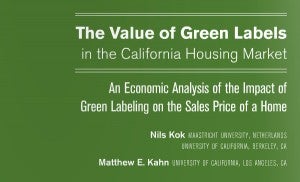From produce to t-shirts, we know certain people are willing to pay more for organic, and that these people often seek out restaurants, vendors and brands that have earned certifications for their commitments to sustainable practices. Labels help consumers, who increasingly face a multitude of product and service offerings, make informed decisions. But what about a sustainably-labeled house? Will people pay more for a certifiably more efficient, or “green,” home?
 A recent study, “The Value of Green Labels in the California Housing Market,” suggests that the market places significant value on certified green homes in California. Such green-labeled homes fetched a 9% premium versus non-labeled homes, based on statewide sales data for 1.6 million homes from 2007 to 2012. This translates to a $34,800 price premium for a home labeled by at least one of three standards: ENERGY STAR, LEED for Homes or California’s own GreenPoint label, on the $400,000 sales price of a non-labeled home. The research was conducted by Matthew E. Kahn, an economics professor at UCLA, and Nils Kok of Maastricht University in the Netherlands, a visiting scholar at the University of California at Berkeley. Their analysis controls for variables known to affect real estate prices including location, size, vintage and the presence of amenities.
A recent study, “The Value of Green Labels in the California Housing Market,” suggests that the market places significant value on certified green homes in California. Such green-labeled homes fetched a 9% premium versus non-labeled homes, based on statewide sales data for 1.6 million homes from 2007 to 2012. This translates to a $34,800 price premium for a home labeled by at least one of three standards: ENERGY STAR, LEED for Homes or California’s own GreenPoint label, on the $400,000 sales price of a non-labeled home. The research was conducted by Matthew E. Kahn, an economics professor at UCLA, and Nils Kok of Maastricht University in the Netherlands, a visiting scholar at the University of California at Berkeley. Their analysis controls for variables known to affect real estate prices including location, size, vintage and the presence of amenities.
The study estimates that the typical single-family California household spends $200/month on utilities, and thus stands to benefit from $720 in annual savings from energy efficiency measures that would reduce energy use by 30%. The authors point out that the $34,800 price premium of a green-labeled home is 48x the annual estimated utility bill savings of $720, suggesting that consumers value efficient homes for more than the direct financial benefits they produce.
All else equal, it is well understood that a resource efficient home uses less energy than an inefficient one, and will therefore have lower operating costs. But Kahn and Kok point out that ‘the added value of a green-labeled home far exceeds both the estimated cost of adding energy efficiency features to a home and the utility-bill savings generated by those improvements.’
Since the non-financial benefits of a green-labeled home are a seemingly large part of their perceived value, effectively promoting energy efficiency requires a targeted marketing approach that taps into the consumer’s values – perhaps some combination of increased comfort, improved indoor air quality and the signal of ‘conspicuous conservation’ that lets your neighbors know your own particular “shade of green.” In fact, the study found that the value of a green-labeled home was positively correlated with the level of environmental ideology of a neighborhood, as measured by the percent of hybrid vehicle registrations.
We tend to focus on cash-flows when doing a cost-benefit analysis of energy efficiency financing programs, weighing the upfront installation costs versus the resulting monthly utility bill savings. This makes sense given that non-financial benefits, to date, have been hard to value. However, this study is an indication that these benefits are indeed monetized at sale – and a 9% price premium sends a strong message that it pays to invest in energy efficiency!
 Last week, Hawaii passed a landmark bill, SB 1087, which will allow the state to create and issue a “Green Infrastructure Bond.” This bond structure will secure low-cost financing for a variety of clean energy installations, with a focus on reaching populations that cannot afford or do not have access to these energy saving improvements today. The bond proceeds will be used to fund an on-bill program currently under development at the Hawaii Public Utilities Commission (PUC). The on-bill program, which is very much in line with EDF’s recommendations for on-bill repayment (OBR), will provide access to low-cost financing for clean energy projects for residential and small commercial customers.
Last week, Hawaii passed a landmark bill, SB 1087, which will allow the state to create and issue a “Green Infrastructure Bond.” This bond structure will secure low-cost financing for a variety of clean energy installations, with a focus on reaching populations that cannot afford or do not have access to these energy saving improvements today. The bond proceeds will be used to fund an on-bill program currently under development at the Hawaii Public Utilities Commission (PUC). The on-bill program, which is very much in line with EDF’s recommendations for on-bill repayment (OBR), will provide access to low-cost financing for clean energy projects for residential and small commercial customers.

